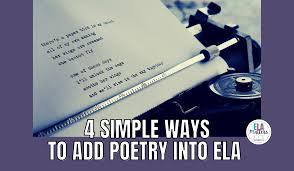I think we can all agree that poetry can be intimidating for students AND teachers! But I think that might be because we keep it hidden away. Students don’t see or read or study poetry often so it just isn’t familiar and therefore can’t be comfortable. So the question is how do we add poetry into ELA?
What if we brought poetry into the classroom in low-key ways that increase familiarity, and hopefully comfort, even before students dive into later analysis?
Here are four simple ways to add poetry into ELA this school year. Read on!
Create a showcase to add poetry into ELA
Dedicate a spot in your classroom to display poetry. Maybe it’s a bulletin board where you feature a series of poems based on a particular theme or to fit a time of year. Check out this free poetry e-book that shares five poems for each month of the year. Print out poems to cover a few months! If you’re like me then you might rarely change or update your bulletin boards so make it last longer by incorporating a general theme or adding a few months at a time.
Create a “take-a-poem” spot that lasts beyond poem in your pocket day in April. Print short poems on sticky notes so students can read them. Maybe even print a bunch one day and include them on students’ desks to set the mood for the day.
Here are a few poems that could brighten the day:
- Joy by Clarissa Scott Delany
- A Birthday by Christina Rossetti
- Short and sweet poems by Shel Silverstein
- or some selections from student-favorite Rupi Kaur: having the strength to rise, stillness, or power
Use attendance questions infused with poetry
How do you take attendance in class? Is it calling out student names with a bellow back of “here” or “present”? Or maybe you use attendance questions, which became a big focus when so many of us were teaching online. A simple way to engage students and to build relationships. Check out this post and this one about using attendance questions in your classroom.
I love to use poetry-infused questions to make poetry just part of the day. You could use poetry-infused questions as part of your weekly rotation. Asking questions like what’s your favorite first line with a series of poems, or which do you like better with two different verses from poems on the same topic. You can even mimic the popular mood checks with poems or poets’ faces.
Here are 40 poetry-infused attendance questions that you can incorporate into your regular rotation or even use everyday (and more) during National Poetry Month in April.
Use Poetry as a calming device or reflection component
You can make poetry part of a check-in or to provide some downtime at a particularly stressful time in class. Use a poem as part of a free-write or response activity choosing a poem that fits a particular moment or mood. Another way to make this an SEL moment is to provide students with poetry-focused coloring pages. These work well as SEL options to gauge your students’ place and space.
Here’s a set of 40 poems that are full page with full poems and designs to provide students with some time and space to decompress. This set also includes half-page options with a full poem, space to color, as well as a response section for students to react and to interact with the poem. You can download this FREEBIE with a poem by Christina Rossetti or check out this set featuring the voices of diverse women poets. These are perfect for Women’s History Month in March, National Poetry Month in April or really anytime of year!
Use poetry-focused podcasts
Poetry podcasts such as Poetry Unbound, The Slowdown hosted by US Poet Laureate Ada Limón, and even the Poetry Foundation’s Audio Poem of the Day can be used in class as part of listening activities or a minds-on to set the tone for the day’s lesson.
These three specific podcasts feature a poem each episode and the briefest of brief discussions of the content. Their brevity – ranging from 1 to 10 minutes (or more if you like) – make them suitable for short bursts of poetry. These activity pages can help to guide students’ listening for any poetry podcast.
Poetry doesn’t have to be difficult! Using these options to add poetry into ELA can help to demystify poetry for your students. So when you’re ready to dive into analysis students are less intimidating and more willing to take a risk with poetry!

